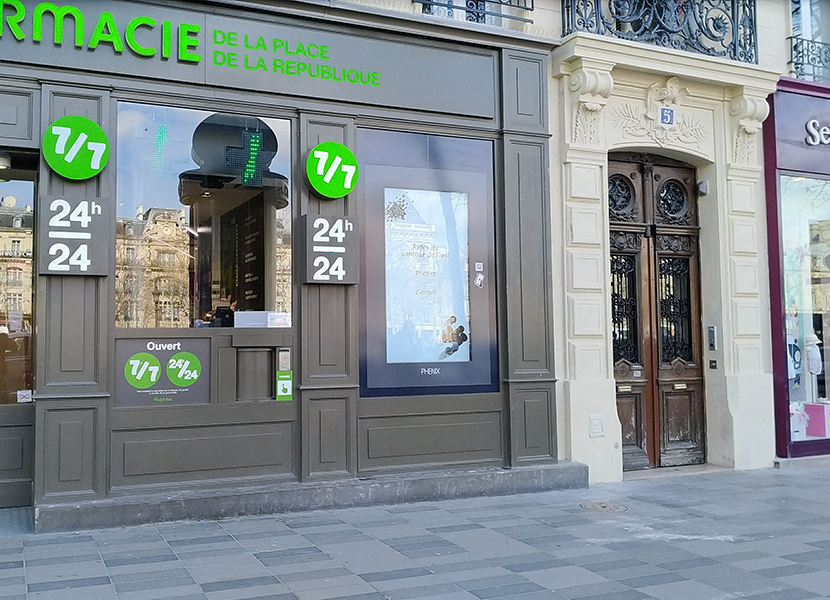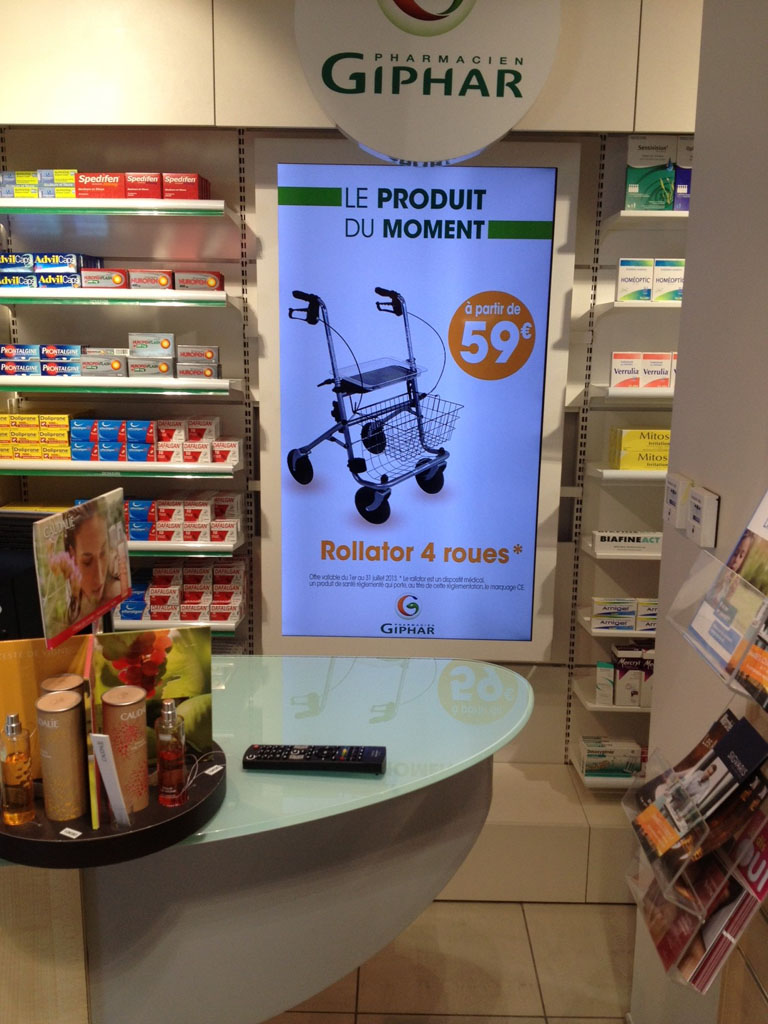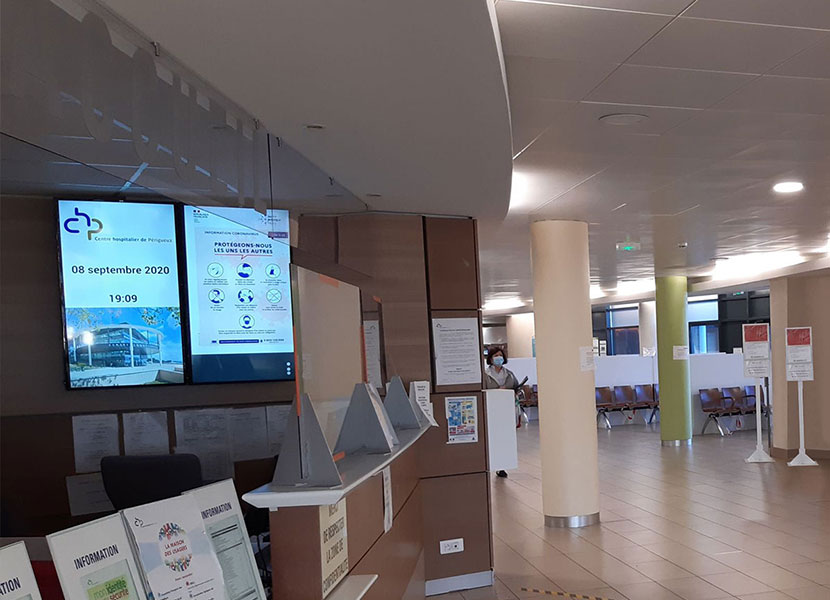Dynamic displays in pharmacies: how to boost performance and combat the epidemic?

Isn’t the most common reason for people to visit a pharmacy is to pick up the medication prescribed by their doctor? Yet these establishments have a vast range of products available for sale without a prescription. Small items, bandages, antiseptics, care and beauty products, and so on.
Pharmacists, like retailers, need to make the most of their entire range. But they are also faced with contemporary challenges, such as adapting their business to the Covid-19 health crisis. Many of them are showing solidarity by reorganizing their establishments to carry out screening tests.
The pharmaceutical sector is thus at the crossroads of two activities: that of commerce and that of contributing to access to healthcare. Thanks to digital tools, it can adapt to a wide range of needs, both for individual purchases and for public health. Among them: dynamic LED displays. Find out in this article how they enable pharmacists to achieve performance gains with an agile organization!
Digital signage: turnkey solutions
Digital signage derives its main advantages from its digital nature. They are solutions that respond effectively to a wide range of communication needs, thanks to the quality :
Hardware
Dynamic display tools have been driven by innovations developed by their manufacturers. Today, they are very thin, light, space-saving, and easy to install anywhere in the pharmacy. What’s more, LED screens have gone from strength to strength. Their brightness is close to that of natural light, and their energy consumption has been reduced (despite better lighting). They have a very long lifespan (around 100,000 hours), with the added benefit of reducing waste to protect the environment.
Integrated software
Dynamic displays can only be used effectively if they are simple and intuitive to manage. Integrated software is the solution for parameterizing dynamic displays without having to devote too much time to the task.
In most cases, all dynamic displays are connected to a central system. This enables a pharmacy to customize the messages displayed on each screen as it sees fit. Content programming is one of the main features of LED displays. It can be designed according to their location (an attractive visual in the window, an informative visual during product pick-up). It can also be tailored to product promotions, or to the time of day.

Digital technology for more effective pharmacy communication

The digital nature of dynamic displays means that changes can be made almost instantaneously, from a single point. All content is displayed on an entire fleet of screens. This content rotation multiplies the amount of information conveyed to audiences. The result is a greater volume of communications and better message retention by audiences.

The efficiency of information transmission is also due to the nature of the content projected on LED screens: animated or video. The human eye is naturally attracted to movement. These types of content effectively capture the attention of pharmacy audiences.
Dynamic displays to interact with pharmacy audiences

Unlike digital, digital is based on interactivity. Tools are digital when their users can navigate an interface and access different types of content or information. These may be kiosks or interactive totems, for example.

In pharmacies, digital solutions are most often used to make a dematerialized product catalog available to the public.Installed anywhere in the establishment, thanks to their stable, rigid base, interactive digital displays can be used by the public, who can navigate them independently. They discover a wide range of products sold in pharmacies, with a potentially very high level of information (product composition, qualities, application advice… even explanatory videos). All this, without the need to mobilize hospital staff. What’s more, such a system improves the customer experience by reducing the feeling of waiting.
Sales performance gains
Pharmacies have the same needs as retailers in terms of visibility and promotion of their products. Dynamic displays offer numerous advantages that contribute directly to their commercial performance:
- Increased point-of-sale traffic. When placed in pharmacy windows, LED screens and their attractive content capture the public’s attention. Media Report has measured that they generate 10 times more visual contacts than a conventional window display. They increase attractiveness by 15%. As a result, passers-by are more likely to enter the pharmacy.
- Increased sales through product promotion. More effective promotional campaigns, thanks to dynamic content, boost sales.
- Increased sales through the sale of advertising space. Digital tools have the advantage of making business more easily assessable through data analysis. A pharmacy that welcomes a large number of visitors can attract the interest of other companies wishing to communicate their products and services via the pharmacy’s screens. They can do this by selling advertising space and monitoring the content displayed.
Dynamic displays help pharmacies fight the epidemic in a post-Covid world
In the context of the health crisis, many pharmacies want to get involved to support collective efforts to contain viruses. Dynamic display solutions help them achieve these objectives by :
- Raising public awareness: by disseminating information of public interest, such as reminders of barrier gestures and new data on the evolution of the epidemic.
- Re-organizing their business to carry out screening tests: pharmacies wishing to carry out screening tests need to manage the flow of people in the establishment differently. Dynamic displays enable them to do this by optimizing their queues. Among other things, the public can independently pre-register on the interactive screens of the digital terminals to be taken care of more quickly. Here, pharmacies find the same advantages in dynamic displays as medical analysis laboratories.
Dynamic displays in pharmacies are high-potential tools for improving sales and organizational performance. Digital content meets the needs of capturing audiences, memorizing messages, selling products, improving the point-of-sale experience… All challenges that have been evolving since the health crisis. Digital technology gives pharmacies the agility they need to adapt to fluctuations in their needs and those of their customers.
In the same
categorie

Digital signage: what’s in it for retailers?

Digital signage totems: enhancing your visual communication
